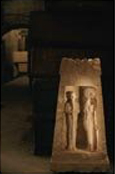The excavations of the University Museum at Marsa Matruh on Bates Island, on the north coast of Egypt's western desert, were conducted by Prof. Donald White (Curator Emeritus, University Museum) between 1985 and 1989. Excavations uncovered a site located on a small island positioned at the end of a protected salt water lagoon.

The excavations of the University Museum at Marsa Matruh on Bates Island, on the north coast of Egypt's western desert, were conducted by Prof. Donald White (Curator Emeritus, University Museum) between 1985 and 1989. Excavations uncovered a site located on a small island positioned at the end of a protected salt water lagoon. During the late Bronze Age its facilities were used during the non-winter months by Aegean mariners to break their voyages between Crete and the southeastern Mediterranean. In addition to modest living quarters and storerooms, the island was equipped with a shop for metalworking, in which simple tools were manufactured for exchange with the local Libyan population who provided the island mariners with water, food, fuel and ostrich egg shells. The pottery wares indicate that the settlement had links to Cyprus, the Aegean, and Canaan, in addition to Egypt and their Libyan neighbors.
The results of the excavations have recently been published in two volumes by INSTAP press. Volume one provide an overview of the area and its recent excavations, the late Bronze Age and historical period occupations, and an introduction to the island’s environmental morphology and history. Volume two provides separate studies of the site’s late Bronze Age and Greco-Roman through Islamic pottery, its metal and lithic tools, its faunal remains, and its archaeobotanical history.
